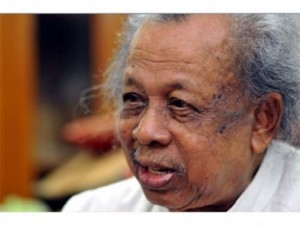โครงการฯ ขอแสดงความเสียใจอย่างสูงต่อการสูญเสียคุณอังคาร กัลยาณพงศ์
โครงการฯ ขอแสดงความเสียใจอย่างสูงต่อสูญเสียคุณอังคาร กัลยาณพงศ์ ศิลปินแห่งชาติด้านกวีนิพนธ์ และขอไว้อาลัยมา ณ ที่นี้
(ที่มาภาพ : หนังสือพิมพ์มติชน)
Obituary : Angkarn Kalayanaphong
Angkarn Kalayanapong, generally acknowledged as dean of contemporary Thai poets, passed away on 25 August 2012. He was 86.
A native of Nakorn Sri Thammarat, he received his school education in his native town, but he owed his early poetic tutelage to his home environment, especially to his mother, who introduced him to traditional Thai literature. By the time he came to Bangkok to study art, he was already a well-read youngster who was thursting for more. The formative years at Silpakorn University opened up new horizons. While being formally trained in Western-style visual art and aesthetics by Prof. Silp Bhrasri, he accompanied one of Prof. Silp’s close associates Prof. Fua Hariphitak to Ayuthaya to copy murals in the ruined temples of the old capital. It was this exposure to traditional Thai art that was to guide him in his creative work as a painter. Angkarn was equally recognized as a poet and a painter, (and let us face it, in contemporary Thai society, he could only physically survive as a painter!)
As a poet, he was originally anathema to Thai academia. His innovations were regarded as a breach of our revered traditional prosody as well as of good taste. It took him decades before he could find entry into school and university curricula, and this was due to the combative efforts of only a few scholars, notably Mom Luang Bunlua Debyasuwan. Whereas most Thai literati were (and still are) familiar with poetic works of the early Bangkok period, especially Sunthon Phu, Angkarn was reaching back to the mid-Ayuthaya period, whose prosodic freedom and and rugged masculinity were dear to him. Angkarn’s poetry could be considered as a renaissance of traditional Thai poetry (before it settled down to mellifluous regularity), and it was this irregularity that he very well exploited to reflect the spirit of the tumultuous new age. (The “mellifluous school” is still very much present, even in political verse which is meant to be belligerent. It simply does not work!) Angkarn’s irregular rhythm has to be heard in order to take its full effect, and he loved to read (or rather chant) his own poems in public. His poetry is the meeting place of the old and the new: poetic expressions (and vocabulary) akin to Ayuthya poetry are interwoven with present-day conversational language, including rude words, that infuriate traditionalists and purists. All this was deliberate. He wanted to prove that the august lineage of Thai poetry is an uninterrupted process. Another innovation of his is prose poetry (or what is known in French as ,,poésie en prose”). He used it with utmost finesse to tell moral tales that seek to emulate Jataka stories.
The technical innovations were not an end in themselves, but a vehicle to transmit contemporary message to contemporary society. Angkarn was very much our contemporary poet. First and foremost, he did not take poetry as a leisurely pastime and was dead serious about the poet’s vocation. Traditional Thai poets were already occasionally expressing their desire to remain immortal, but they were mostly thinking in aesthetic terms. Angkarn was unashamedly didactic: he viewed the role of the poet as that of a seer, a spiritual leader, and above all, a missionary. The poet was to act as a voice of conscience, not only to his own society, but to the human race. Like a Bodhisatwa, he announced in one of his best-known poems, “The Poet’s Pledge”, that he was prepared to renounce Nirvana in order to be able to care for his fellow human beings. Again, this typical “Oriental” artist was ready to learn from the experience of the West: the idea of the apotheosis of the arts, which his Italian professor must have shared with him, conspired with the ideal of a Bodhistava to construct an impregnable bastion of belief in the power of the arts to shape human conduct and to forge a solid foundation for society. This quest can express itself in a negative way: Angkarn censures vehemently those who reject or fail to recognize the value of art. Only a great poet can turn irascibility into exquisite poetic expression.
Scaling metaphysical heights did not prevent Angkarn from taking issue with mundane realities. He was a socially engaged poet. A supreme nature poet, he never remained on the descriptive level, but took on an activist stance. Decades before the advent of “Green” movements in Thailand, Angkarn saw through the impending environmental dangers and could already pinpoint their root causes, as can be witnessed in his magistral work, Lamnam Phu Kradung (1969). He was alert to the political machinations of corrupt governments and never hesitated to take to the streets, when parliamentary means had been exhausted. Armed with his poetry, he combatted corrupt politicians with his words, as was the case with his poem ,,Makawan”, which he delivered live at Makawan Bridge during a demonstration and subsequently published. His brand of activism was not motivated by political partisanship, but governed by moral rectitude. More than half a century, his social and political stand never suffered shifts and changes, unlike with some of his colleagues of the mellifluous school. An honest man like Angkarn had no need to mince his words. Rarely do we see the likes of him. But surely, one in half a century is too little for a “failed state” like ours.
Chetana Nagavajara
——————–
